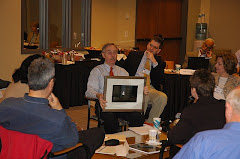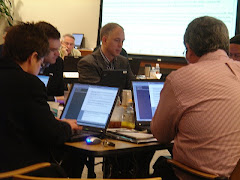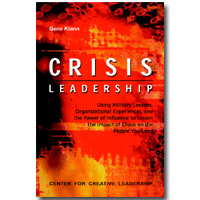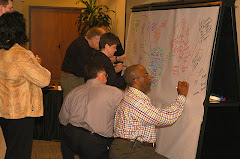 David Noer has a new edition of Healing the Wounds, his classic work on dealing with downsizing. David offers these tips, reprinted here from his Web site (http://davidnoer.com/):
David Noer has a new edition of Healing the Wounds, his classic work on dealing with downsizing. David offers these tips, reprinted here from his Web site (http://davidnoer.com/):1. Myth: There is a direct relationship between reducing “people costs” and organizational productivity. A layoff on a Friday will result in productivity gains on the following Monday.
Reality: People are not “things” to be added or deleted to the production equation with mathematical sterility. Humans are—just that, humans—and are carriers of feelings and emotions. The overwhelming consensus of downsizing research is that layoffs do not achieve their “going in” productivity goals. Survivors of most organizations are angry, depressed, anxious and fearful. They are not able or willing to take risks or focus on increasing customer service. At the very time organizations need them to be the most creative and energetic; they hunker down in the trenches, absorbed in their own toxic survivor symptoms. They may look as though they are working hard, but it is an illusion.
Reality: People are not “things” to be added or deleted to the production equation with mathematical sterility. Humans are—just that, humans—and are carriers of feelings and emotions. The overwhelming consensus of downsizing research is that layoffs do not achieve their “going in” productivity goals. Survivors of most organizations are angry, depressed, anxious and fearful. They are not able or willing to take risks or focus on increasing customer service. At the very time organizations need them to be the most creative and energetic; they hunker down in the trenches, absorbed in their own toxic survivor symptoms. They may look as though they are working hard, but it is an illusion.
2. Myth: Survivors – people who remain in organizational systems after downsizing – will work hard because they will be grateful that they were lucky enough to keep their jobs.
Reality: Survivor guilt - formulated by the same dynamics that affect survivors of other forms of trauma – is alive and well in post-layoff organizations. Guilt and its relatives – anxiety and depression – are not the stuff of motivation! Organizational leaders need to implement strategies to deal with the disabling consequences of survivor guilt before they will have truly motivated employees.
Reality: Survivor guilt - formulated by the same dynamics that affect survivors of other forms of trauma – is alive and well in post-layoff organizations. Guilt and its relatives – anxiety and depression – are not the stuff of motivation! Organizational leaders need to implement strategies to deal with the disabling consequences of survivor guilt before they will have truly motivated employees.
3. Myth: Organizational leaders should not tolerate any whining and bitching concerning the downsizing process.
Reality: Organizationally sanctioned processes that facilitate the venting of repressed feelings and emotions are a necessary means to the end of moving employees back to productivity. Without the healthy externalization of layoff induced anger, fear, and anxiety, employees will remain crippled by layoff survivor sickness. In fact, research shows their symptoms will get worse.
Reality: Organizationally sanctioned processes that facilitate the venting of repressed feelings and emotions are a necessary means to the end of moving employees back to productivity. Without the healthy externalization of layoff induced anger, fear, and anxiety, employees will remain crippled by layoff survivor sickness. In fact, research shows their symptoms will get worse.
4. Myth: During downsizing, managerial communication needs to be clear, planned, objective, and structured. Expressing uncertainly, ambiguity, or dealing in feelings and emotions is not useful.
Reality: Feelings and emotions are the currency of the managerial realm. Surviving employees are attempting to deal with a toxic brew of productivity hindering emotions and need to feel authorized to talk about them. Employees would much rather have managers tell them that they don’t know something as opposed to having them not say anything or make something up. Managers who are strong enough to show their own vulnerability and uncertainty not only help their employees, they help themselves.
Reality: Feelings and emotions are the currency of the managerial realm. Surviving employees are attempting to deal with a toxic brew of productivity hindering emotions and need to feel authorized to talk about them. Employees would much rather have managers tell them that they don’t know something as opposed to having them not say anything or make something up. Managers who are strong enough to show their own vulnerability and uncertainty not only help their employees, they help themselves.
5. Myth: Time heals all wounds. Layoff survivor symptoms may flare up initially, but quickly disappear a few weeks after the reductions take place.
Reality: Without planned interventions, layoff survivor symptoms not only linger, they intensify. Research conducted in one organization five years after the initial layoff showed survivor symptoms not only intensified, but many employees were demonstrating passive-aggressive behavior – faking it and “going through the motions” in some contexts, and expressing increased anger and hostility in many others. A large number of organizational systems today – public, private, government – are only operating at a small fraction of their potential because they are dragged down by employees with long term survivor symptoms.
Reality: Without planned interventions, layoff survivor symptoms not only linger, they intensify. Research conducted in one organization five years after the initial layoff showed survivor symptoms not only intensified, but many employees were demonstrating passive-aggressive behavior – faking it and “going through the motions” in some contexts, and expressing increased anger and hostility in many others. A large number of organizational systems today – public, private, government – are only operating at a small fraction of their potential because they are dragged down by employees with long term survivor symptoms.
6. Myth: In tough times, the most effective managers “suck it up,” are tough minded, brutally honest, and don’t tolerate “touchy-feely” distractions.
Reality: “Sucking it up” is precisely the wrong strategy for dealing with downsizing, change, and transition. It is a defense mechanism - a form of evasion that anchors behavior in the past and prevents productive engagement and personal growth. Leadership in the post-layoff environment is a helping, not a controlling relationship, and requires reaching out, not closing down and hiding behind a facade of toughness and control. Honesty grounded in a helping orientation is an absolute necessity. Honesty grounded in “brutality” may help the manager vent his or her own anger, but it will ultimately harm the manager, the employee, and the organization. Labeling authenticity, empathy, and helping behaviors with the derogatory term “touchy-feely,” or making disparaging comments that one lives in the “real” world, are additional examples of diversionary defense mechanisms. The most effective managers have learned the power of engaging in helping relationships and use that power to re-recruit employees and restore organizational productivity.
Reality: “Sucking it up” is precisely the wrong strategy for dealing with downsizing, change, and transition. It is a defense mechanism - a form of evasion that anchors behavior in the past and prevents productive engagement and personal growth. Leadership in the post-layoff environment is a helping, not a controlling relationship, and requires reaching out, not closing down and hiding behind a facade of toughness and control. Honesty grounded in a helping orientation is an absolute necessity. Honesty grounded in “brutality” may help the manager vent his or her own anger, but it will ultimately harm the manager, the employee, and the organization. Labeling authenticity, empathy, and helping behaviors with the derogatory term “touchy-feely,” or making disparaging comments that one lives in the “real” world, are additional examples of diversionary defense mechanisms. The most effective managers have learned the power of engaging in helping relationships and use that power to re-recruit employees and restore organizational productivity.
7. Myth: Once things get back to normal, the epidemic of downsizings will stop and job security will return.
Reality: We are experiencing a fundamental shift in the psychological contract that connects employee to employer. When the economy becomes more positive, the frequency of mass layoffs will diminish, but long-term, lifetime employment with one organization is a thing of the past. Employees will have to rely on maintaining transferable marketable skills and continually cultivate their professional network. That will provide the only true employment security in the brave new world of the new psychological employment contract.
Reality: We are experiencing a fundamental shift in the psychological contract that connects employee to employer. When the economy becomes more positive, the frequency of mass layoffs will diminish, but long-term, lifetime employment with one organization is a thing of the past. Employees will have to rely on maintaining transferable marketable skills and continually cultivate their professional network. That will provide the only true employment security in the brave new world of the new psychological employment contract.
8. Myth: Downsizing erodes loyalty, motivation, and commitment.
Reality: In the new reality, employees will be loyal to their profession and motivated more by the work itself rather than the organization where they perform that work. We are caught in the confusing and painful cross currents of a paradigm shift. Once employees break their organizational codependency – caused by indexing their self-esteem and relevance on the organization where they work as opposed to the work itself – there will be a quantum increase in motivation. This will occur because employees will be driven by an inner sense of purpose rather than contrived external motivational techniques.
Reality: In the new reality, employees will be loyal to their profession and motivated more by the work itself rather than the organization where they perform that work. We are caught in the confusing and painful cross currents of a paradigm shift. Once employees break their organizational codependency – caused by indexing their self-esteem and relevance on the organization where they work as opposed to the work itself – there will be a quantum increase in motivation. This will occur because employees will be driven by an inner sense of purpose rather than contrived external motivational techniques.
9. Myth: Despite the current epidemic of downsizing, organizations need to find ways to tie in employees over the long term.
Reality: The best strategy for organizational survival in the new reality is to attract employees because of the work. In the new paradigm the best and most talented employees will have options; they will choose their employers because they want to be there, not because they have to be there. Leading these new, “volunteer” employees will require much more creativity and collaboration than managing a work force that is “tied in” and trapped by benefits, services, and social systems that reward fitting in and conformity and motivate by fear of job loss.
Reality: The best strategy for organizational survival in the new reality is to attract employees because of the work. In the new paradigm the best and most talented employees will have options; they will choose their employers because they want to be there, not because they have to be there. Leading these new, “volunteer” employees will require much more creativity and collaboration than managing a work force that is “tied in” and trapped by benefits, services, and social systems that reward fitting in and conformity and motivate by fear of job loss.
10. Myth: Employees who keep their jobs – survivors – are better off than those who must leave - victims.
Reality: Both those who stay and those who leave are, in a sense, “victims” of the paradigm shift to the new psychological employment contract. Despite, often significant, economic issues, some who leave are able to re-frame their job loss, move away from victimhood, and discover a wake-up call. They use the experience to find work that has more personal relevance and remove their self-esteem from the unpredictable vicissitudes of organizational life. Survivors, too have the opportunity to turn away from victimhood. They can shed the symptoms of layoff survivor sickness, and take personal charge of their lives and careers. It is a difficult struggle for both those who stay and those who leave, but the gain is well worth the pain.
Reality: Both those who stay and those who leave are, in a sense, “victims” of the paradigm shift to the new psychological employment contract. Despite, often significant, economic issues, some who leave are able to re-frame their job loss, move away from victimhood, and discover a wake-up call. They use the experience to find work that has more personal relevance and remove their self-esteem from the unpredictable vicissitudes of organizational life. Survivors, too have the opportunity to turn away from victimhood. They can shed the symptoms of layoff survivor sickness, and take personal charge of their lives and careers. It is a difficult struggle for both those who stay and those who leave, but the gain is well worth the pain.







